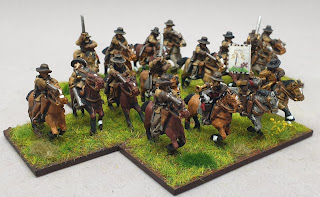Sir Nicholas Crispe’s Regiment of Horse
A regiment of horse from the King's Oxford Army, that took an absolute hammering at Cirencester in September 1643: Cirencester had been taken by Essex in 1642, before Rupert recaptured the town in February 1643. Essex would again retake the town for Parliament in September 1643. Crispe's Regiment lost a number of cornets with white fields and black and white fringes at Cirencester; they are recorded in a muster in April 1644 as being four Troops but only having one cornet (in theory colours could not be flown by a troop or company that had lost their colours until they had captured a colour from the enemy). I've represented them carrying the cornet of Sgt Major Christopher Wormsley's Troop.
Crispe was the son of a London Alderman, and at the outbreak of war he was an important Royalist agent in London, before he fled the capital to Oxford when an intercepted letter revealed that £3700 was owed to him ‘for secrett service done for his Majestie'. Commissioned to raise a regiment of horse in July 1643, the regiment would serve as part of Cleveland's brigade. Crispe wasn't with his regiment very often, preferring to spend his time attending upon the Queen.
Crispe had made his fortune through the East India Company and the Guinea Company. His trading interests (not to forget his fleet of ships, and substantial wealth) meant he was commissioned (and funded) a fleet of fifteen warships which ferried troops to and from Ireland, as well as bringing much needed armaments into the country.
Battle honours are: the storm of Bristol; Cirencester; First Newbury; Cheriton; Cropredy Bridge; Lostwithiel; Second Newbury; the relief of Donnington; Langport; Torrington; before surrendering at Truro in March 1646.
After Charles I's execution, Crispe would fund and raise funds for the future Charles II, and was one of the committee members sent to Breda to meet Charles. Upon the Restoration much of his monies lost were reimbursed by the Crown, and a number of high offices given to him.
 |
| The cornet's hat used to belong to his original head before I swapped it for a bare head |
When he died his body was buried at St Mildred's in Bread Street London (which was destroyed during the Blitz), his heart was laid to rest inside a casket under a bust of Charles I at St Paul's Church, Hammersmith. Victorian redevelopment saw his body and heart reunited in a new tomb in the churchyard of St Paul's in 1898.













Excellent as ever. Is painting the bugler's coat to match the cornet a deliberate act? Looking at it, it does help highlight the command stand so might be an idea I nick!
ReplyDeleteThanks Dex. Since discovering that Ashley's RoH had a cinquefoil on their trumpet banner (as depicted on Ashley's tomb) I have been trying to use cornet colours and designs on trumpeters.
ReplyDeleteApart from Ashley's we also know that Brereton bought black taffeta trumpet banners for his RoH.
Certainly makes command stands stand out, plus it helps with the 'what colour should I go for' moment.
Curse you autocorrect! Ashley? Astley!
DeleteLovely looking Royalist cavalry unit! I too like the coronet coat colour and I too will nick that idea!
ReplyDeleteBest Iain
Thanks Iain.
DeleteWhether or not it is 'accurate' we shall never know, but it does make things easier for the painter who has run out of ideas...
A wonderful period and a great looking cavalry!
ReplyDeleteThanks Phil
Delete